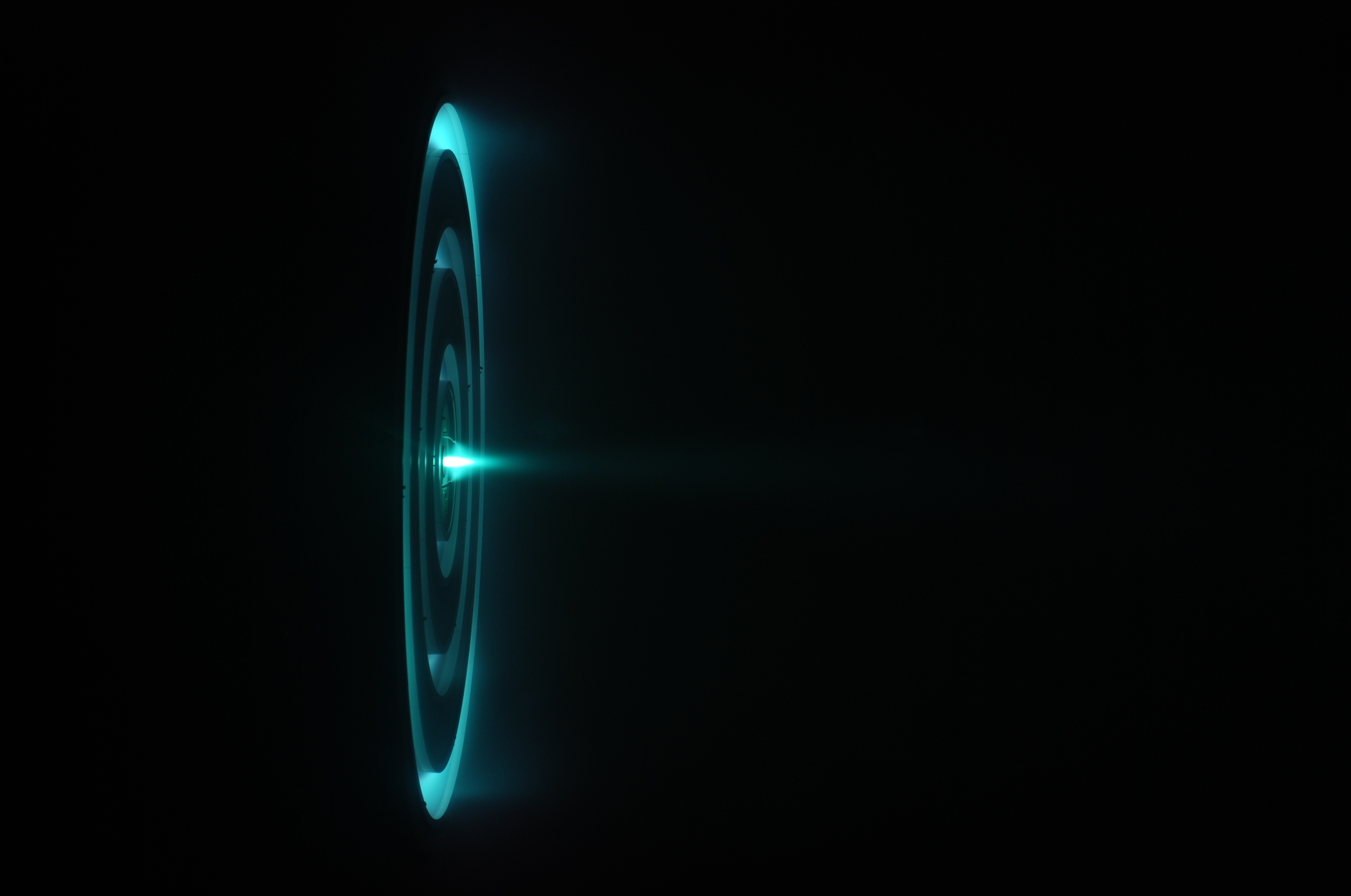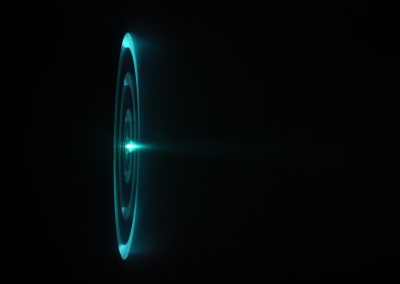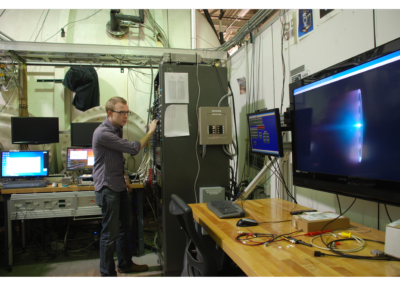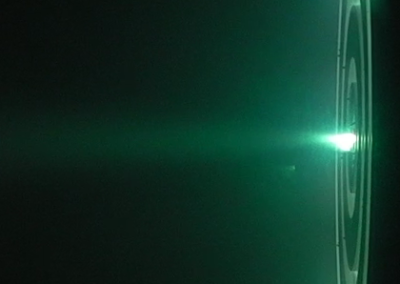Thruster
X3 – Nested Channel Hall Thruster

Low-power operation of the X3 at PEPL.
Developed
2011-2013
Approx. Specs.
Ø80 cm x 20 cm, 230 kg
Tested at PEPL
2013 – ongoing
Developer
PEPL, AFRL, NASA GRC, NASA JPL
“Nested-channel Hall thrusters have been identfied as a means to increase Hall thruster power levels above 100 kW while maintaining acceptable device size and mass. In a recent Broad Agency Announcement, NASA identified high-power electric propulsion (up to 300 kW) as enabling for a variety of mission structures, including human space exploration. Additionally, a 2010 NASA team found that high-power electric propulsion was key to allowing affordable travel to asteroids and near-Earth destinations by reducing launch mass up to 50%. NASA hopes to implement a system that has a broad power and specific impulse range for maximum flexibility within a mission. The multiple discharge channels of a nested-channel Hall thruster allows for throttling far beyond that of a single-channel Hall thruster. This essential feature makes these devices ideal candidates for a system to meet NASA’s needs and goals. Following the success of the proof-of-concept X2, a 10-kW class two-channel nested Hall thruster the Plasmadynamics and Electric Propulsion Laboratory (PEPL) at the University of Michigan, in collaboration with NASA and the Air Force Office of Scientific Research, developed the X3, a 100-kW class three-channel nested Hall thruster.”
“The X3 is designed to operate efficiently on both krypton and xenon propellants from 200–800 V discharge voltage and at total discharge currents up to 250 A. The total power throttling range of the X3 is 2–200 kW. The thruster is approximately 80 cm in diameter and weighs 230 kg. Each of the three discharge channels features an inner and outer electromagnet for a total of six, each of which is controlled separately.”
During high-power tests of the X3, Hall et al. “successfully measured the performance of the X3 for a range of conditions spanning total power levels from 5 to 102 kW. These conditions consisted of discharge voltages from 300 to 500 V and current densities that were 0.63, 1.00, and 1.26 of a reference value. The seven channel combinations of the thruster were throttled across this range of settings. For each test point, [Hall et al.] directly measured thrust using a high-power inverted-pendulum thrust stand, and from those thrust measurements and thrust telemetry, we calculated specific impulse and efficiency values.” The “results demonstrated that a three-channel 100-kW class NHT can offer comparable or even improved performance over high-power single-channel thrusters. The X3 demonstrated total efficiencies ranging from 0.54–0.67 and total specific impulses from 1800–2650 seconds [during this test], experiencing the peak efficiency at 500 V discharge voltage. Additionally, the results indicate that none of the available channel combinations were significantly over- or under-performing the rest, demonstrating comparable specific impulse and efficiency at a fixed discharge voltage and current density. The sum of the single-channel thrusts generally was not significantly different than the three channels operating together for a given discharge voltage and current density, a surprisingly result that differed from previous NHT testing. Ultimately, the X3 demonstrated new levels of Hall thruster power (102 kW), thrust (5.4 N), and discharge current (247 A). These results demonstrate the capability of Hall thrusters and NHTs for cargo and crew transport applications and show that the X3 represents a significant milestone on the roadmap to Mars.”
(This summary was directly quoted from the work of Hall et al. in “30-kW Performance of a 100-kW Class Nested-channel Hall Thruster”, presented at the 34th International Electric Propulsion Conference in 2015, and “High-Power Performance of a 100-kW Class Nested Hall Thruster” presented at the 35th International Electric Propulson Conference in 2017.)
Selected Publications
Implementation and Initial Validation of a 100-kW Class Nested-channel Hall Thruster
Hall, S., Florenz, R., Gallimore, A., Kamhawi, H., Brown, D., Polk, J., Goebel, D., Hofer, R.
The X3 100-kW Class Nested-Channel Hall Thruster: Motivation, Implementation, and Initial Performance
Florenz, R
30-kW Performance of a 100-kW Class Nested-Channel Hall Thruster
Hall, S.J., Cusson, S.E., and Gallimore, A.D
30-kW Constant-Current-Density Performance of a 100-kW-class Nested Hall Thruster
Hall, S.J., Cusson, S.E., and Gallimore, A.D
High-Power Performance of a 100-kW Class Nested Hall Thruster
Hall, S.J., Jorns, B.A., Gallimore, A.D., Kamhawi, H., Haag, T.W., Mackey, J.A., Gilland, J.H., Peterson, P.Y., and Baird, M.J.
Characterization of a 100-kW Class Nested-Channel Hall Thruster
Hall, Scott J.
Update on the Nested Hall Thruster Subsystem for the NextSTEP XR-100 Program
Jorns, B.A., Gallimore, A.D., Hall, S.J., Peterson, P.Y., Gilland, J.E., Goebel, D.M., Hofer, R.R., and Mikellides, I.
Operation of a High-Power Nested Hall Thruster with Reduced Cathode Flow Fraction
Hall, Scott; Jorns, Benjamin; Gallimore, Alec
Performance and High-Speed Characterization of a 100-kW Nested Hall Thruster
Scott J. Hall, Benjamin A. Jorns, Sarrh E. Cusson, Alec D. Gallimore, Hani Kamhawi, Peter Y. Peterson, Thomas W. Haag, Jonathan A. Mackey, Matthew J. Baird, James H. Gilland
Plasma Plume Characterization of a 100-kW Nested Hall Thruster
Scott J. Hall, Benjamin A. Jorns, Alec D. Gallimore, Hani Kamhawi, Wenshang Huang




